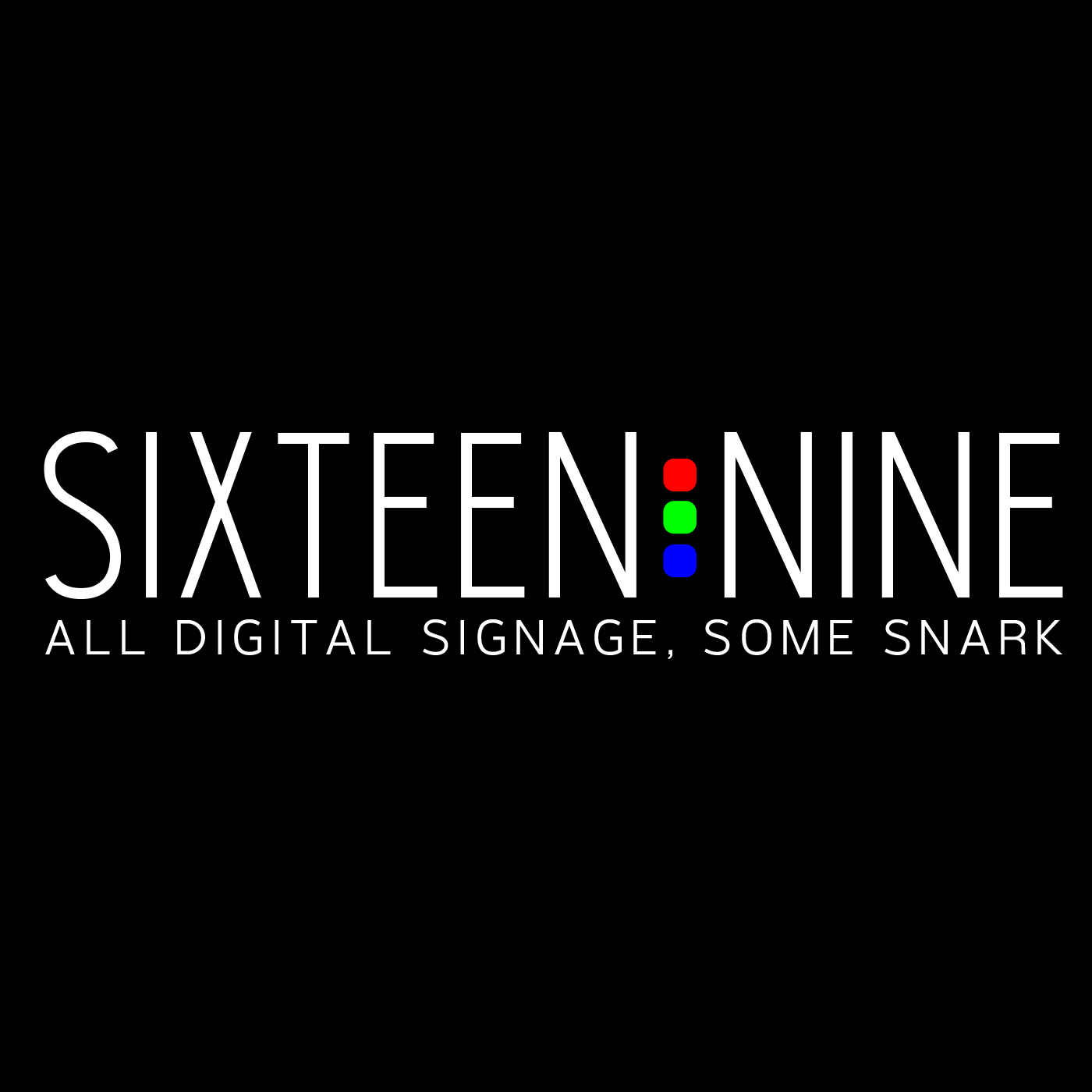Episodes

Wednesday Oct 25, 2017
Peter Cherna, Scala
Wednesday Oct 25, 2017
Wednesday Oct 25, 2017
This week we are doing a little wayback thing, talking to someone who has been working specifically at digital signage for almost 25 years, for a company that’s been at it for 30.
One of the events that’s part of of all the digital signage week things in New York next week is one that’s marking three decades in business for Scala, one of the best known brands in this industry.
Peter Cherna joined the company as a software developer in 1993, and he’s now Scala’s Chief Product Officer - basically the guy making all the decisions around what the content management system does and delivers.
We chatted about the really early days of Scala, which was started in Norway and built at that time off the old Commodore Amiga computer and software platform. He was at Commodore, and like several other developers, got off what was a sinking ship and joined Scala.
We get into a little bit of the history of the company and this industry, but also look at what’s going on with technology these days, and how things are evolving.
Subscribe to this podcast: iTunes * Google Play * RSS

Wednesday Oct 18, 2017
Yahav Ran, Synect Media
Wednesday Oct 18, 2017
Wednesday Oct 18, 2017
When I get asked about digital signage installations that I think really have it together, I tend to talk about Microsoft’s retail stores, and more recently, the crazy one by many 100s video wall at the check-in counters at Orlando’s airport.
Turns out both projects were pulled together by Synect Media, a Seattle-area agency that is as much an integrator as it is a creative design studio.
Yahav Ran started the company in 2011, really on the back of work he was doing for Microsoft. But his experience in digital signage goes back a lot longer, to his days with the Israeli video wall software company Cnario.
Those two jobs, and a bunch of others, have made Ran a very busy guy these days, working on and pitching projects built around video wall content and solutions. I managed to slow him down recently and ask about his company and the thinking and execution on really big digital canvases.
Subscribe to this podcast: iTunes * Google Play * RSS

Wednesday Oct 11, 2017
Mark Boidman, Peter J. Solomon Company
Wednesday Oct 11, 2017
Wednesday Oct 11, 2017
If you want to get a sense of what’s really going on with the digital out of home media business and the technology ecosystem that feeds into it, you need to pay attention to Mark Boidman.
That’s his gig - looking at the opportunities and risks of the business, as a partner running the marketing services wing of New York investment banking house Peter J. Solomon Company.
That company has been deeply involved in the sector for the last five years, putting Boidman right in the middle of the business as an advisor and the lead on some big mergers and acquisitions.
With me in my home office and him talking at his iPad at the company’s midtown Manhattan offices, we had a great chat about the state of digital OOH and what’s going to happen. We also revisit his lost career as a cruise ship host. No, really.
Subscribe to this podcast: iTunes * Google Play * RSS

Wednesday Oct 04, 2017
Neil Farr, Acquire Digital
Wednesday Oct 04, 2017
Wednesday Oct 04, 2017
Being a best-kept secret in an industry can be deadly for a company, but it’s worked out OK for Neil Farr and his Leicester, England company Working Solutions, which trades under the brand Acquire Digital.
For 20 years, the company has been developing a meaty, diverse software platform that will do all the core aspects of digital signage, but also allows for a lot of customization.
Farr admits he and his team have not been all that good at getting the name out there in the ecosystem, but it hasn’t hurt them much. Acquire has several high profile clients and jobs - like an amazing three-dimensional pylon on the Vegas strip - and a lot of business just comes in based on references from happy clients and partners.
We caught up recently via Skype, and Farr walked me through the history of the company, what’s different about what they do and offer, and what’s coming with technology that keeps him excited about the business.
Subscribe to this podcast: iTunes * Google Play * RSS

Wednesday Sep 27, 2017
Laura Davis-Taylor, High Street
Wednesday Sep 27, 2017
Wednesday Sep 27, 2017
Laura Davis-Taylor is a really well-known and much-loved expert when it comes to how digital fits in retail.
She was a consultant for many years, but more recently has worked for some very large agencies - dealing with equally large retail and brand accounts.
Now she’s back doing the consulting thing, by her choice. She’s started High Street, a retail experience collective, with a couple of old friends and now business partners. Though just up this summer, the boutique consultancy has already bagged some major accounts.
In this episode, Laura talks about the challenge in retail in the age of Amazon, and how getting people in stores and prompting them to buy stuff is not solved alone by sticking in screens or other kinds of tech.
If you sell to or work in retail, you’ll want to have a listen …
Subscribe to this podcast: iTunes * Google Play * RSS

Wednesday Sep 20, 2017
David Labuskes, AVIXA
Wednesday Sep 20, 2017
Wednesday Sep 20, 2017
I was in the Washington, DC area last week for what turned out to be the rebranding of Infocomm as AVIXA - a loose acronym for the Audiovisual and Integrated Experience Association.
The trade association had invited me, and a pile of other trade journalists, for a press conference and follow-ups about … something. They wouldn’t say what and had us signing NDAs promising we wouldn’t spill the beans ahead of time.
It’s a lot more than just a name change for Infocomm, which will still be the name of the big annual trade show and versions of it in other countries. The new AVIXA branding reflects much deeper thinking by the InfoComm board and executive team, which is run by CEO David Labuskes.
On the tail end of a crazy-busy launch day, and in the middle of a cocktail party, I managed to grab Labuskes for a chat, to find out what AVIXA is all about, and what it means for people and companies in the digital signage industry.
Subscribe to this podcast: iTunes * Google Play * RSS

Wednesday Sep 13, 2017
Peter Fahlman, Telemetry
Wednesday Sep 13, 2017
Wednesday Sep 13, 2017
A lot of companies run by creatives and software developers have found their way into the digital signage business on the backs of projects they delivered, but I wouldn’t really see that happening with a company that’s all about online payments.
That’s exactly, though, the back story on Telemetry, a Vancouver, BC start-up that grew out of a need by the sister company to visualize all the data they were generating from transactions. The software team looked around the marketplace for applications that would do the job, and when they concluded what was out there didn’t fit, they wrote their own.
With home-grown digital dashboards around the office showing the team what was going on in the business, CEO Peter Fahlman and his colleagues concluded what they had was a great tool - but also something they could productize … without really even knowing what digital signage was all about.
Now Telemetry is a full, cloud-based digital signage CMS, tightly tied in with Google’s Chrome services. Enabling real-time dashboards is, to me, the particularly interesting aspect of what the company does, but Fahlman tells me in this conversation that they’re more than just live pie charts and graphs.
Subscribe to this podcast: iTunes * Google Play * RSS

Wednesday Sep 06, 2017
David Douglas-Beveridge, SmartContent.TV
Wednesday Sep 06, 2017
Wednesday Sep 06, 2017
If you spend any time clicking around the internet, you are very quickly going to bump into a website that is using a slider - a piece of browser functionality that shifts text, images and video in and out of a web page.
The most heavily used slider out there comes from a German company called Themepunch, and that little coding shop has spun off a new company and product called SmartContent.TV.
The company’s digital signage platform is built directly off the Revolution Slider that’s been licensed some 4 million times for WordPress websites - allowing everyone from expert WordPress developers to total newbies to build and launch animated, dynamic digital signage shows for very little money. If you want a sense of what sliders can do, visit the website, it has multiple sliders on the landing page.
SmartContent just came out of beta and is now marketing a solution that runs on $60 Amazon FireSticks and costs about $15 a month to use,.
In this episode, I have a chat with David Douglas-Beveridge, co-founder of SmartContent, to talk about the roots of the product, how it’s used, and where it’s going.
Subscribe to this podcast: iTunes * Google Play * RSS

Wednesday Aug 30, 2017
Zach Klima, WaitTime
Wednesday Aug 30, 2017
Wednesday Aug 30, 2017
If your digital signage screens are there to make something faster, better or easier for the people who are looking at them, you are doing good things.
That’s the idea behind a Detroit start-up called WaitTime - a digital signage and smartphone app solution that uses cameras and artificial intelligence software to give people at sports and entertainment venues mission critical information like which washroom lineups are shortest, and where to go to get intermission beer and drinks quickly.
The data that comes out of those camera feeds and software inform game and concert-goers where lines are shortest, which is great for fans - but also for venue operators. The screens load-balance lines and reduced the number of times people abandon lines at concessions. That means more sales.
CEO and founder Zach Klima says the systems tend to pay for themselves at arena and stadiums in less than a year.
In our chat, we talk about the roots of the platform, how it works, who’s backing it, and how it can play nicely with the digital signage companies who already service the sports and entertainment venue market.
Subscribe to this podcast: iTunes * Google Play * RSS

Wednesday Aug 23, 2017
Florian Kall, LightnTec
Wednesday Aug 23, 2017
Wednesday Aug 23, 2017
LED billboards and signs are now commonplace, and not just in Times Square and other landmark locations in big cities.
But putting in LED has its challenges. Cost is the obvious one, but there are other issues, like the engineering needed to ensure a structure can handle all the weight involved with typical LED boards.
They’re a lot thinner and lighter than they used to be, but with all the metalwork, plastic and wiring, they still result in big, heavy walls.
So I was intrigued by a self-funded start-up out Germany, called LightnTec, that has developed technology that does LED on thin, lightweight plastic rolls of film. It’s light enough to just put up like a vinyl banner on some scaffolding or hang off a wall - without worrying about the weight.
LG showed a transparent LED film at a couple of trade shows this year, so if you were around, you might have a rough idea of what’s up here. But that was low-rez and one color of light - white. What LightnTec is developing is the full RGB range of millions of colors, and it does full motion video.
I spoke recently with CEO Florian Kall about this Made In Germany technology.
Subscribe to this podcast: iTunes * Google Play * RSS

Wednesday Aug 16, 2017
Curt Thornton, Provision
Wednesday Aug 16, 2017
Wednesday Aug 16, 2017
Hologram is up there with artificial intelligence as one of the most abused terms in tech these days - with all kinds of stuff being labelled as holograms when they’re nothing more than reflections or projections.
Provision has been marketing what it calls 3D holographic media for a bunch of years, and while purists might argue it’s not fully a hologram, it’s a lot closer to holograms than most stuff. Walk into a drug store chain and you might see a kiosk with a motion media piece floating in front of a coupon kiosk, visually and physically detached from any display device.
It’s eye candy. It’s wow factor. But it’s also media that’s making a difference, because they draw eyeballs and pull people over to machines that might otherwise get ignored. They put these things in and coupon redemption rates in the stores went from 1 to 2 percent to 17 percent - across multiple brands, and in the case of the drug store chain, across 500 stores.
I talk to Provision founder and CEO Curt Thornton about his company, the technology and where things are going, including big national rollouts and life-sized 3D holograms.
Subscribe to this podcast: iTunes * Google Play * RSS

Wednesday Aug 09, 2017
Kristin Russell, Arrow Intelligent Systems
Wednesday Aug 09, 2017
Wednesday Aug 09, 2017
Kristin Russell jokes about Arrow being a massive company few people even know about - with $24 billion in annual sales and some 18,000 people walking around with Arrow on their business cards, in 90 countries.
She runs Arrow Intelligent Systems, which does everything from design engineering and integration services to global logistics. One of the key areas for the business unit is digital signage, and while Arrow has been on the edges of the industry for years, it got a lot more involved when it acquired Seneca Data a couple of years ago. The company picked up a tech firm highly respected in the industry for its media players and video wall servers.
We met recently at Seneca’s offices in Syracuse, NY, and got into a lot of things in our chat.
Russell talks about how Arrow is very different from traditional distribution companies, and how the company mantra is to be thinking and working on ideas that are five years out and real.
We get into her background as CIO for the state of Colorado. Among her accomplishments in that gig was attracting Arrow to Denver, with no sense she’d end up there, running a large division with its own P&L.
We also talk about her being a Global President of a fast-growing company, in an industry that is still overwhelmingly male.
Subscribe to this podcast: iTunes * Google Play * RSS

Wednesday Aug 02, 2017
Hacking Dangers In Digital Signage, with Gary Feather, CTO, Nanolumens
Wednesday Aug 02, 2017
Wednesday Aug 02, 2017
I’m changing up the podcast a little bit this week.
I have my own rule that I want to talk to a bunch of other companies first before I talk to one a second time.
I’ve also made this podcast about people and not issues.
But this week I am talking to Gary Feather, CTO of the display company NanoLumens, even though I spoke with his boss Rick Cope last summer.
Here’s why. Feather is running a webinar next week on security, and the steps he thinks any substantial digital signage operator out there should be taking to ensure their screens and systems are not compromised by hackers.
The risk is not just about keeping some teenagers from getting naughty movies up on the screens in a store, though that’s definitely not good. It’s also about ensuring the connected media players driving screens are not the side door access into private and mission critical systems within businesses. Target’s big hack three years ago came in through the HVAC systems.
It’s an important subject, and we spend this podcast previewing a little of what he plans to talk about August 8th.
Subscribe to this podcast: iTunes * Google Play * RSS

Wednesday Jul 19, 2017
Michael Higgins, Harris School Solutions
Wednesday Jul 19, 2017
Wednesday Jul 19, 2017
Public schools would seem like a natural fit for digital signage because of all the communications that circulate, all the time, in K-12 schools.
A software company that’s focused on the education market - Harris School Solutions - recently announced a product that’s an interesting blend of digital signage and smartphone apps. It’s designed to communicate what’s on the menu in school lunchrooms, and get feedback from students and their parents about whether they like the food getting loaded on cafeteria trays.
In this episode, I talk to Michael Higgins about EZSchoolLunch, and about the challenges of developing digital signage software solutions, selling them into bureaucracies and dealing with the long lead times of schools and school districts.
Subscribe to this podcast: iTunes * Google Play * RSS

Wednesday Jul 12, 2017
Robin Carlisle, Framestore Labs
Wednesday Jul 12, 2017
Wednesday Jul 12, 2017
Robin Carlisle is Global Head of Creative for Framestore Labs, a UK-based creative technology shop that specializes in making beautiful and cinematic real-time visuals.
Labs is part of a larger company that has been doing amazing visuals for years. For example, that’s Framestore’s work in movies like Gravity, which somehow imagineers what happens when satellite debris takes out a space station.
Carlisle’s company is involved in all kinds of projects, and recently, has done work that falls squarely in the digital signage and interactive signage buckets. That includes work done for the London Stock Exchange, Morgan Stanley and Ford.
We connected by Skype, with Carlisle joined by the company’s production head Jonny Dixon, just in case the questions got too deep into the technical weeds. They didn’t.
Subscribe to this podcast: iTunes * Google Play * RSS

Wednesday Jul 05, 2017
Steve Rickless, Tripleplay
Wednesday Jul 05, 2017
Wednesday Jul 05, 2017
Steve Rickless, one of the founders of the UK firm Tripleplay, believes likes a lot of people that technology is converging, and thinks his company is in a good spot because it has already converged its technology.
The company started in IP television for the corporate market, but by 2008 was doing a blended hardware and software solution that did IPTV and digital signage off the same user experience, and running off the same boxes.
While start-ups have been trying to adapt low-cost Android set-top as signage players, with mixed results, Tripleplay has for years been using the kinds of commercial-grade set-top boxes you’ve seen behind hotel TVs as digital signage players. They're not necessarily small or pretty, but they just work and work.
From the perspective of Rickless, Tripleplay's CEO, the way forward is one solution doing many things for enterprise customers. He doesn't see that great a future for companies with silo'd technologies that just do one thing.
We spoke recently at InfoComm about the company’s roots, the size of business these days, and where things are heading. The chat was on the show floor, so there’s lots going on in the background.
Subscribe to this podcast: iTunes * Google Play * RSS

Wednesday Jun 28, 2017
Meric Adriansen, D3
Wednesday Jun 28, 2017
Wednesday Jun 28, 2017
I find, more and more, that some of the more successful companies in this business are a bit like stealth submarines. They run silent and deep, and you don’t hear much about them or see them around.
That would apply pretty nicely to D3, a New York company that is in the LED display business. D3 started outside in New York’s Times Square - with some iconic LED boards. Now the company is indoors, with narrow pixel pitch displays in some premium retailers. I’d say who, but that will get the company in trouble with certain publicity-wary clients. Suffice to say, you’d reply, “Oh really …”
D3 is also doing corporate, including a job it CAN talk about - the amazing 13K lobby of the new Netflix offices in Los Angeles.
I saw D3 recently at InfoComm, and asked why the company just had a teeny booth and no LED displays, when it was surrounded by less successful companies with massive displays.
The management team did that because LEDs are already becoming a commodity, D3 Co-Founder and Managing Partner Meric Adriansen told me. The real secret is in the video processing and software and, of course, the idea and the content. It’s also, of course, waaaay cheaper to pull off, and easier for set-up and teardown.
Adriansen and I went to the back of a noisy InfoComm hall to chat, and you can hopefully hear us over the guys who decided to tear down some nearby scaffolding right after we started.
Sigh.
Subscribe to this podcast: iTunes * Google Play * RSS

Wednesday Jun 21, 2017
James Fine, Telecine
Wednesday Jun 21, 2017
Wednesday Jun 21, 2017
James Fine has been around the digital signage ecosystem since the earliest days. He founded Telecine in the mid-80s to do high-end video production for the corporate sector. By the mid-90s, he was getting into signage, putting networked screens in Quebec casinos.
We talk about the early days of the business - like spending $25,000 for 62-inch plasma displays for a retail job. That’s $25K PER display.
Things have changed, and both the industry and his business have grown. Telecine now does a turnkey solutions service for a variety of clients, and the work has won awards - notably for the great data-driven signage you’ll see if you visit a Bloomberg office.
Fine and Telecine are from Montreal, and one of the things we get into in this chat is why there are so many great creative shops coming out of that city.
We spoke last week at InfoComm.
Subscribe to this podcast: iTunes * Google Play * RSS

Wednesday Jun 14, 2017
Eric Henry, Tightrope Media Systems
Wednesday Jun 14, 2017
Wednesday Jun 14, 2017
Tightrope Media Systems has been around the digital signage business for 20 years, and if you’ve heard of the company, there’s a decent chance you thought, like me, that the Minneapolis company was a broadcast software firm that also did a signage CMS.
Turns out it was the other way around, and Tightope started as a digital signage software company doing digital menu boards on old CRT screens for schools. The big driver was coming up with a dumbed-down application that people with more important things to do around a school could use.
That early platform seemed to have another likely home with community broadcasters, which is how Tightrope found its way into that side of the business. These days, it’s about 50:50 digital signage and broadcast.
Tightrope is in Orlando this week for InfoComm, and the big thing the team is showing off is an integration that turns $150 Apple TV boxes into managed digital signage players. It’s something that’s only really been possible in the last few months, and Tightrope President Eric Henry fills me in on how that happened, and the broader story of the company.
Subscribe to this podcast: iTunes * Google Play * RSS

Wednesday Jun 07, 2017
Rick Mills, Creative Realities (CRI)
Wednesday Jun 07, 2017
Wednesday Jun 07, 2017
If you have followed the digital signage business for a few years, you have probably seen stories about the financial tailspins of a set of companies that eventually got blended together as Creative Realities, or CRI for short. Sitting in the cheap seats watching it all go down, I’m sure I wasn’t the only one thinking, Well, this won’t end well.
Then the company merged with another company, ConeXus World. Which had me thinking, Who? And then, Why???
Turns out there was a master plan here, started years earlier. Rick Mills, the CEO at ConeXus, had long had roll-up plans in the digital signage business, and picking up CRI was his first, but not his only move.
He brought some structure to the business, calmed things down, including clients, and in the last couple of quarters, brought a company that had been hemorrhaging red ink into the black.
Now he’s aggressively hiring people, looking to expand, and planning to acquire some smaller competitors to become one of the big boys in the digital signage solutions business.
Subscribe to this podcast: iTunes * Google Play * RSS


